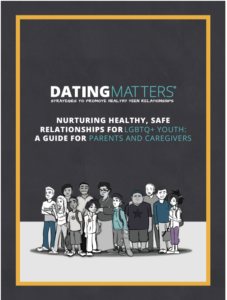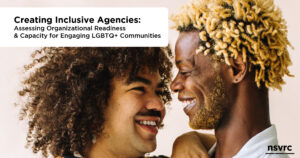New Resources for Supporting LGBTQ+ Communities and Preventing Sexual and Intimate Partner Violence
 New resources from CDC’s VetoViolence and the National Sexual Violence Resource Center (NSVRC) provide practitioners with additional tools in working to prevent sexual and intimate partner violence and create inclusive, tailored programming with LGBTQ+ communities.
New resources from CDC’s VetoViolence and the National Sexual Violence Resource Center (NSVRC) provide practitioners with additional tools in working to prevent sexual and intimate partner violence and create inclusive, tailored programming with LGBTQ+ communities.
CDC’s Dating Matters program — a teen dating violence prevention program — now includes a guide to healthy, safe relationships for LGBTQ+ youth and a guide to nurturing healthy, safe relationships for LGBTQ+ youth for parents and caregivers. Both guides can be used as stand-alone resources or alongside the Dating Matters youth and parent programs. Learn more about these new guides and the entire Dating Matters Toolkit here.
NSVRC’s two new resources provide practical guidance for organizations. Creating Inclusive Agencies: Assessing Organizational Readiness & Capacity for Engaging LGBTQ+ Communities can serve as a roadmap for organizations to evaluate and enhance their readiness to engage LGBTQ+ communities in affirming ways. Because building internal capacity is key to fostering trust and authenticity in partnerships, it’s essential for organizations to assess their current practices, policies, and cultural competency.
This tool outlines actionable steps and areas for consideration, including:
- Evaluating organizational culture and staff readiness.
- Building knowledge and skills to affirm LGBTQ+ individuals.
- Creating a welcoming and inclusive environment for both prevention efforts and survivor services.
Transformative Prevention Programming: Sexual violence prevention in Lesbian, Gay, Bisexual, Transgender, and Queer or Questioningg (LGBTQ+) communities is a guide designed for prevention practitioners at the state and community level, offering a comprehensive look at preventing sexual violence in LGBTQ+ communities. It emphasizes a nuanced understanding of the diverse experiences within LGBTQ+ communities and provides adaptable strategies for creating effective prevention programs.
- An overview of challenges and opportunities for preventing violence in LGBTQ+ communities.
- A context for tailoring prevention initiatives to meet local needs.
- Resources and examples to inspire transformative, community-centered approaches.
A health equity approach to preventing sexual violence requires that efforts be informed by the lived realities of those most affected by violence. This guide empowers practitioners to create culturally relevant and inclusive prevention strategies that address root causes and promote systemic change.
Ultimately, these tools encourage organizations to move beyond surface-level inclusivity and embrace meaningful, systemic change. By doing so, they contribute to a broader culture of safety, respect, and equity—key ingredients in preventing violence.

